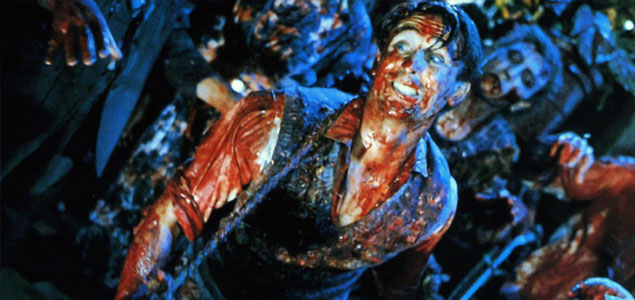
Braindead (Perter Jackson, 1992).
A certain logic exists in the fact that Herschell Gordon Lewis, the father of gore cinema, matured to become a voice of reference in the field of advertising marketing. As a paradigmatic example of a man capable of achieving excellence in two completely different lives, Gordon Lewis is, for some, a world authority on direct marketing, the author of such books as The Businessman’s Guide to Advertising and Sales Promotion(1974) and How to Handle Your Own Public Relations (1977) and, for others, the Godfather of Gore, director of titles such as Blood Feast (1963) and 2000 Maniacs (1964), where formal disorder was compensated by a pioneering daringness to transgress taboos of representation. If one stops to think for a moment about the matter, the fact that Gordon Lewis and his producer David Friedman invented a film subgenre that found its identifying mark in the rhetoric of spilt blood and amputated limbs had little to do with transgression: it was rather a case of satisfying a market demand that was uncatered for, and, at the same time, of marking out a territory for exploitation that had remained virgin up to that point.
Gordon Lewis, the first person who showed, on a screen, in splendorous colours, how an arm was severed or a tongue pulled out, did not belong, then, to the spiritual descendants of the Marquis de Sade or the Comte de Lautréamont – the true agents provocateurs: founders of new paths of knowledge beyond Moral and Reason – but, probably, was closer to the logic of thinking of the characters that inhabit Otra Dimensión, the first novel by Grace Morales: the founding fathers of the first dating websites in Spain or the leisure managers that, at a certain moment, after the successive intuitions of Apocalypse of 9/11 and 3/11, decided that the last word in feelgood nocturnal offerings would be liberal partner-swapping clubs – another way of habilitating a lubricious trench (the evolutionary succession of the anti-atomic shelters of the 1950s) in the midst of the inferno: a space for not being and being other(s), although without being able to escape the existential dander, whether one’s own or someone else’s.
Before gore, both Gordon Lewis and his sidekick David Friedman were making a profit from another genre: the “nudies”, those films of naked people that, originally, to be able to show more flesh than the regulators’ codes allowed, used the pretext of presenting themselves as documentaries on the emerging naturist camps of the late 1950s and early 1960s. Friedman had, in that context, what could be considered a brilliant idea: in one of the films, he decided to shoot one of the naturists jumping on a trampoline. This particular intuition for the mise en scènemeant that his film contained a glandular dynamism that, to a large extent, was an entire premonition of the body language of the porno films that had not yet given rise to their lucrative industry. The example of David Friedman and Gordon Lewis offers, then, an idea that deserves to be taken into consideration: at one of its departure points, the Excess Screen is not transgression, but simply a functional, almost administrative, response to the question of what the audience wants to see.
If gore cinema was born with Blood Feast, it could (and perhaps should) have died with Peter Jackson’s Braindead (1992), a film that advanced as the development of a mathematical proposition on the escalation of excess and culminated in the (apparent) death by implosion of the subgenre. In one of its scenes, the main character found himself forced to flee a horde of zombies (or infected humans) through a room that had already been the scenario of a previous mass slaughter: a room bathed in blood, with its floor dotted with cut-off heads. In order to avoid a slip that, given the circumstances, could be fatal, the protagonist decided to cross the space to his (provisional) salvation by jumping on the heads as if they were something like a path of stepping stones on a river of blood.
In the promotional interviews, Peter Jackson mentioned as a reference the films of Buster Keaton, with Seven Chances (1925) and its amazing final chase scene at the head. The reference was pertinent: after all, if gore were related with any pre-existing form, its most direct antecedent would be slapstick. A slapstick where the custard pies would have been substituted by cut-off heads, as left perfectly clear by some moments of Re-animator (1985) by Stuart Gordon.
“What Sennet said over and over again was that comedy was not about being funny. It was about being desperate. What, besides desperation, could make a person walk on a telephone wires thirty feet off the ground, then smash through a skylight and bang off a busted mattress, twenty feet below?” writes Jerry Stahl in I, Fatty, a novel disguised as an autobiography of Fatty Arbuckle, the star of slapstick who also became the first media martyr of a Hollywood that started to forge its own dark legend through sensationalism, crime reports and gossip columns. If we take note of what Stahl explains, we have no other remedy than to consider slapstick as an aesthetic form that is potentially more dangerous – for its practitioners – than gore: after all, in slapstick, the sense of entertainment is supported by its condition of reality – the actor could, literally, cripple himself – while gore is, always, a choreography of a simulacrum. Let us revise, then, some old acquired prejudices: slapstick is closer to snuff than to that gore cinema with which, always in a picturesque way – as in the cases of Cannibal Holocaust (1980) and Guinea Pig (1985) – people have wanted to relate it. Here is, then, one of the paradoxes that arises from all paranoid views of the Excess Screen: a form traditionally considered harmless – slapstick – has more to do with the death wish than a form traditionally misinterpreted as perverse – gore – and the hospital case histories of acrobats of excess such as Harold Lloyd – who lost two fingers and a fair chunk of his hand when playing with a bomb that he thought was just a prop and that turned out to be a real explosive – or Buster Keaton himself can certainly vouch for it.
“We watched the “Mondo Cane” documentaries, where it was impossible to tell the fake the images of false atrocities and executions from the real ones. And we liked it like that. Our voluntary complicity in this blurring of truth and reality in the Mondo films alone made them possible, and was taken up by the entire media landscape, by politicians and churchmen. Celebrity was all that counted. If denying God made a bishop famous, what choice was there? We liked mood music, promises that were never kept, slogans that were meaningless. Our darkest fantasies were pushing at a half-open bathroom door as Marilyn Monroe lay drugged amongst the fading bubbles“, wrote J.G. Ballard in the pages of his autobiography Miracles of Life. The writer credited the documentary by Gualtiero Jacopetti, Paolo Cavara and Franco Prosperi with an important role in the most radical and visionary work of his literary oeuvre: The Atrocity Exhibition (1970), a seminal text from an era governed by the subjective appropriation of a violent imaginary and its recycling as the painted – and sexualised – wallpaper of our subconscious.
In fact, that touch of distinction of the mondo cinema that, based on the 1962 film, would develop into an entire subgenre was not so much in the pulverisation of taboos of representation, but in the mixture of the brutal and the trivial, harmonised through an off-screen narration that, playing with the registers of sensationalist language, ended up affirming an essentially distanced and cynical look at the totality. The mondo films no longer exist, but their sensitivity has infiltrated our lives: in those gossip programmes that play on the perpetual delay of the Great Revelation, while off-screen voices pour sarcasm on the dignity of whichever celebrity has become their latest prey, or on those YouTube videos where the memory of slapstick is denigrated to encourage the giggling typical of stag nights or the company dinner unleashed to alcoholic chaos. The Excess Screen no longer occupies the space of the transgression – if, as such a screen, it ever did occupy it – but rather it is the matching decor (of the spirit of the times) in our multimedia habitat. In such a context, perhaps it is a good idea to ask about the space of the true transgression and, in any event, consider whether transgression continues being, in fact, possible.
A Serbian Film (2010) by Srđan Spasojević is the latest film that, through the rhetoric of excess, has managed, somehow, to cause an uproar, generate debate, encourage dynamics of lynching, converting public opinion into a mob illuminated by the torches of disinformation: in a television programme on a generalist channel, there was a guest who considered that the Ministry of the Interior had to intervene in response to the provocation caused by having programmed A Serbian Film at a festival specialising in fantastic and horror films. Spasojević’s film can be included within the tradition of that gore cinema that, effectively, did not die with Braindead: after a phase in which horror movies made the odd return, under the influence of the oriental tradition, to the poetics of the suggestion that they were moving between a Val Lewton-type purity and resorting to what could be called post-production fright, gore has been reborn uniting with explicit imagery the desire to relate itself to different sources of the transgression discourse (with frequent turns of the screw on the religious: see the notable Martyrs (2008) by Pascal Laugier).
Even those film experts most in agreement with the portrayal of the extreme counter their defence on the freedom of watching A Serbian Filmwith a negative valuation of the excellence or good quality of Spasojević’s film. A Serbian Film is a horror movie that, in turn, wants to be political cinema: its most debated scene is that showing the rape of a baby at the very moment of its birth. Little is said about the end of the film: the moment in which the bodies of the protagonist and his family are taken to a place off screen that we will never see. That off-screen place is, supposedly, the shooting of a necrophiliac porn film using those corpses. Spasojević’s political thesis is not especially subtle, but nobody could accuse him of being opaque: from cradle to grave, the Serbian is pornographic bait. We could broaden the thesis: not just the Serbian…
There is an edifying exercise that all internet users can practice: detecting in the visible and safe parts of the web, some mutations of pornography. For example, the kind of videos that YouTube does not penalise as pornographic and that, in consequence, allow the following to be uploaded to its site without any viewing access restrictions: spit fetish videos, of Japanese female students mutually licking each other’s faces, foot fetishism videos, videos involving playing games with food… In short, all belonging to the world of what has traditionally been considered sexual perversion, with the displacement of the focus of attention outside the strictly genital as a common denominator. Other forms of post-porno on YouTube would have fascinated J.G. Ballard: such as educational videos by Brazilian doctors who instruct users on how to proceed to catheterize the female bladder. The only possibility for one of the identifying features of old porno – a close-up of an open vagina – is thus passed off as medical representation, through a disturbing mannequin doll: a post-organic pornography, which evokes the fetishist imaginary of, for example, Pierre Molinier.
But there are more routes loaded with surprises: for example, the one that allows users to discover, in something as apparently harmless as the Wish Lists of an online store such as Amazon.com, a territory for a kind of de-sexualised mutation of prostitution. Wish Lists are usually the place where a new archetype – the “Financial Mistress”: a dominatrix who only aspires to be financially fêted by her admirer – talks with her client through something that is not even a barter economy: there can be no greater satisfaction than that of buying a present for someone who has promised to ruin you, wear out your credit card and extinguish your savings account as the last word in sexual domination fantasies. The interesting thing is that these new forms of pornography have managed to be, directly, pornography without pornography, sex without sex, transgression for the user without the hassle involved in the old languages of transgression. In summary, the type of satisfaction of a guilty desire that one find day was articulated by Gordon Lewis and David Friedman through the invention of gore cinema with the coldness, cleanness and calculating attitude of a competent sales agent. Of course, in this cynical anti-utopia, it is necessary to prepare a space for the scapegoat: Srđan Spasojević or the man who took too long to realise that the alphabet had changed.



Leave a comment